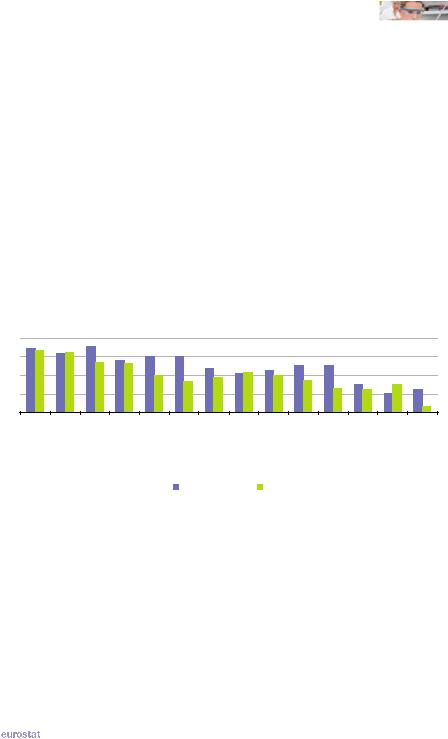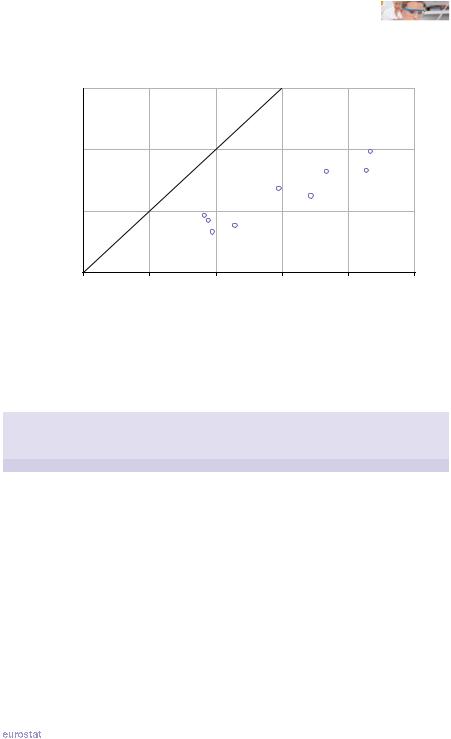
- •Foreword
- •Introduction
- •1. Economy and finance
- •2. Population
- •3. Health
- •4. Education and training
- •5. Labour market
- •6. Living conditions and social protection
- •7. Industry, trade and services, tourism and the information society
- •8. Agriculture, forestry and fisheries
- •9. International trade
- •10. Transport
- •11. Environment
- •12. Energy
- •13. Science and technology
- •Glossary
- •Abbreviations

Labour market
Labour market statistics measure the involvement of individuals, households and businesses in the labour market, where the former generally offer their labour in return for remuneration, while the latter act as employers. The market outcomes – for example, employment, unemployment, wage levels and labour costs – of these relationships heavily affect not only the economy, but directly the lives of practically every person.
The economically active population, also know as the labour force, is made up of employed persons and the unemployed. Employed persons include employees as well as employers, the self-employed and family workers (persons who help another member of the family to run a farm or other form of business). Members of the population who are neither employed nor unemployed are considered to be inactive. Persons in employment are those who, did any work for pay or profit, or were not working but had a job from which they were temporarily absent. The amount of time spent working is not a criterion and so full-time and part-time workers are included as well as persons on temporary contracts (contracts of limited duration).
Main findings
The labour force in the EU 27 in 2011 was composed of around 240.4 million persons aged 15 to 64 of whom 216.7 million were in employment. The activity rate is the share of active persons in the total population and in 2011 for the EU 27 this ratio stood at 71.2 %. The employment rate is generally calculated as the share of employed persons in the total population of working age and was 64.3 % in 2011 in the EU 27 – see Table 5.1.
Particular care should be taken when comparing labour market data between different countries given there are differences in the age criteria used to calculate activity and employment rates. Furthermore, care should be taken if the most recent data are not for the same year, as is the case in most of the analysis presented in this chapter. The global financial and economic crisis impacted strongly on labour markets and this can be seen clearly in employment and unemployment indicators. For example, the employment rate for the EU 27 peaked at 65.8 % in 2008, dropped to 64.5 % in 2009 and further still to 64.1 % in 2010, before recovering slightly to reach 64.3 % in 2011.
|
The EU in the world 2013 — a statistical portrait |
|
57 |
|

|
|
|
5 |
|
Labour market |
|
|
Among the G20 members the activity rate among persons aged 15 or more was below 50 % in Turkey and Saudi Arabia (both 2009). At the other end of the scale the Brazilian rate of 68.6 % (2009 data) was the second highest, below the 71.2 % activity rate recorded for the EU 27 (2011 data).
In all G20 members the activity rate of men was higher than the corresponding rate for women, in other words a greater proportion of the male population was active in the labour force than the proportion of the female population. Only in Canada was the difference between male and female activity rates less than 10 percentage points. The gender difference was over 30 percentage points in Indonesia and Mexico, reached 43.2 percentage points in Turkey, and peaked at 56.8 percentage points in Saudi Arabia.
The high gender difference in Indonesia was, in part, due to a particularly high activity rate for men (83.6 %). Brazil and Mexico had the next highest male activity rates, both around 80 %. Most of the other G20 members recorded male activity rates between 70 % and 80 %, with South Africa’s male activity rate of 61.2 % well below this range.
By contrast, the high gender differences in Saudi Arabia and Turkey reflected exceptionally low female activity rates in these countries, 17.4 % in Saudi Arabia and 27.6 % in Turkey. For the remaining G20 members the female activity rate ranged from 43.5 % in Mexico to 58.7 % in Australia, with Canada (62.4 %) and the EU 27 (64.9 %) above this range.
Table 5.1: Activity and employment rates, persons aged 15 and more, 2010
(%)
|
|
Activity rate |
|
|
Employment rate |
|
||
|
Total |
Male |
Female |
Total |
|
Male |
|
Female |
EU-27 (1) |
71.2 |
77.6 |
64.9 |
64.3 |
|
70.1 |
|
58.5 |
Argentina (2) |
60.8 |
73.9 |
49.1 |
55.7 |
|
68.4 |
|
44.4 |
Australia |
65.5 |
72.5 |
58.7 |
62.1 |
|
68.8 |
|
55.6 |
Brazil (2) |
68.6 |
80.2 |
57.9 |
62.9 |
|
75.3 |
|
51.5 |
Canada |
67.0 |
71.7 |
62.4 |
61.6 |
|
65.4 |
|
57.9 |
China (3) |
59.7 |
: |
: |
: |
|
: |
|
: |
India |
: |
: |
: |
: |
|
: |
|
: |
Indonesia (2) |
67.2 |
83.6 |
51.0 |
61.9 |
|
77.4 |
|
46.7 |
Japan |
60.5 |
71.9 |
49.8 |
57.5 |
|
68.0 |
|
47.5 |
Mexico |
60.4 |
79.3 |
43.5 |
57.3 |
|
75.1 |
|
41.2 |
Russia (4) |
62.6 |
70.6 |
56.0 |
57.9 |
|
64.9 |
|
52.1 |
Saudi Arabia (2) |
49.9 |
74.2 |
17.4 |
47.2 |
|
71.5 |
|
14.6 |
South Africa (2) |
53.1 |
61.2 |
46.0 |
40.5 |
|
47.7 |
|
34.0 |
South Korea |
61.0 |
73.0 |
49.5 |
58.7 |
|
70.1 |
|
47.8 |
Turkey |
48.8 |
70.8 |
27.6 |
43.0 |
|
62.7 |
|
24.0 |
United States (5) |
64.7 |
71.2 |
58.6 |
58.5 |
|
63.7 |
|
53.6 |
(1) 2011, persons aged 15-64. (2) 2009.
(3) 2008.
(4) Persons aged 15-72.
(5) Persons aged 16 and more.
Source: Eurostat (online data codes: lfsi_act_a and lfsi_emp_a) and the International Labour Organisation (Key indicators of the labour market)
58 |
|
The EU in the world 2013 — a statistical portrait |
|
|

|
|
|
Labour market |
|
5 |
|
|
The relative position of the G20 members in terms of the employment rate was similar to that for the activity rate. The main difference was in South Africa, where the employment rate was just 40.5 % (2009 data), some 12.6 percentage points below the activity rate and this was the lowest employment rate among the G20 members. South Korea, Saudi Arabia (2009 data), Japan and Mexico recorded employment rates that were particularly close to their activity rates, indicating low unemployment.
Figure 5.1 focuses on a particular part of the working age population, namely persons aged 15 to 24. Although this age group is considered to be part of the working age population, many young people are not part of the labour force because they are involved in other activities, notably secondary or tertiary education or compulsory military service. In comparison with the activity rates presented in Table 5.1, in all of the G20 members (with data available) the gender difference in activity rates was smaller among the younger population than the whole population. In fact, for South Korea, Japan and Canada the female activity rate was higher than the male activity rate. The gender difference in the activity rate for younger persons was over 20 percentage points in Mexico and Turkey, and between 10 and 20 percentage points in Indonesia, Saudi Arabia, Brazil and Argentina.
Figure 5.1: Youth activity rate, persons aged 15-24, 2010(1) |
|
|
|
|
|
||||||||
(%) |
|
|
|
|
|
|
|
|
|
|
|
|
|
80 |
|
|
|
|
|
|
|
|
|
|
|
|
|
60 |
|
|
|
|
|
|
|
|
|
|
|
|
|
40 |
|
|
|
|
|
|
|
|
|
|
|
|
|
20 |
|
|
|
|
|
|
|
|
|
|
|
|
|
0 |
Canada |
|
|
|
|
|
Japan |
|
|
|
|
|
|
Australia |
(Brazil2) |
StatesUnited |
(Indonesia2) |
Mexico |
Russia |
EU-(273) |
(Argentina2) |
Turkey |
(AfricaSouth2) |
KoreaSouth |
(ArabiaSaudi2) |
||
|
|
|
|
|
Male |
|
|
Female |
|
|
|
|
|
(1) China and India, not available. |
|
|
|
|
|
|
|
|
|
|
|
||
(2) 2009. |
|
|
|
|
|
|
|
|
|
|
|
|
|
(3) 2011. |
|
|
|
|
|
|
|
|
|
|
|
|
|
Source: Eurostat (online data code: lfsi_act_a) and the International Labour Organisation (Key indicators of the labour market)
|
The EU in the world 2013 — a statistical portrait |
|
59 |
|

|
|
|
5 |
|
Labour market |
|
|
Among the 216.7 million persons aged 15 to 64 in employment in the EU 27 in 2011 around five in every six (83.5 %) were wage and salary earners, in other words paid employees; the remainder were mainly self-employed persons (including employers) while family workers (who are not paid employees) made up 1.5 % of total employment. An analysis by working status shows very different patterns across the G20 members, with only Canada and South Africa reporting a similar pattern to that observed for the EU 27.
The United States and Russia stand out with very high shares of paid employees, in excess of 90 %; at the other end of the ranking, around two thirds of persons in employment were paid employees in Brazil and Mexico, this share falling to three fifths in Turkey and down to one third in Indonesia. The self-employed contributed close to one half of all employment in Indonesia and more than one quarter in Mexico and Turkey, but less than one tenth in Japan, Russia and the United States. In many G20 members a relatively small proportion of employment is made up of family workers, generally less than 2 %. Nevertheless, family workers contributed 13.6 % of total employment in Turkey and 17.3 % in Indonesia.
Data availability for part-time employment is relatively weak. In the EU 27, part–time employment accounted for 9.0 % of male employment in 2011 and 32.1 % of female employment. For men, this share was relatively low compared with other G20 members, although lower rates were observed in South Korea and Turkey. For women, the rate in the EU 27 was one of the higher rates observed, although in Australia, Argentina and Japan more than one third of women in employment worked on a part-time basis.
Table 5.2: Working status, persons aged 15 and more, 2009
|
Number of persons |
Share of employment by working status (%) |
||
|
in employment |
Employees |
Self-employed |
Family workers |
|
(1 000) |
|||
|
|
|
|
|
EU-27 (1) |
216 685 |
83.5 |
15.0 |
1.5 |
Argentina |
10 402 |
76.0 |
23.3 |
0.7 |
Australia |
10 953 |
88.4 |
11.3 |
0.3 |
Brazil (2)(3) |
92 689 |
66.4 |
24.8 |
4.6 |
Canada (4) |
17 126 |
84.6 |
15.3 |
0.1 |
China |
: |
: |
: |
: |
India |
: |
: |
: |
: |
Indonesia |
104 871 |
33.4 |
49.3 |
17.3 |
Japan (3) |
62 820 |
86.9 |
9.4 |
3.2 |
Mexico (5) |
43 344 |
66.1 |
27.4 |
6.5 |
Russia (6) |
70 965 |
92.7 |
7.2 |
0.1 |
Saudi Arabia |
: |
: |
: |
: |
South Africa |
13 306 |
84.6 |
14.5 |
0.9 |
South Korea |
23 506 |
70.0 |
24.3 |
5.7 |
Turkey (7) |
22 593 |
60.9 |
25.5 |
13.6 |
United States (8) |
145 362 |
93.0 |
6.9 |
0.1 |
(1) 2011, persons aged 15-74.
(2) Persons aged 10 and more; analysis by working status does not sum to 100 % due to persons whose working status is not classified. (3) Analysis by working status does not sum to 100 % due to persons whose working status is not classified.
(4) 2008.
(5) Persons aged 14 and more. (6) 2008, persons aged 15-72. (7) 2010.
(8) 2008, persons aged 16 and more.
Source: Eurostat (online data code: lfsa_egaps) and the International Labour Organisation (Key indicators of the labour market)
60 |
|
The EU in the world 2013 — a statistical portrait |
|
|

|
|
|
Labour market |
|
5 |
|
|
Unemployed persons are those without work, but actively searching work. The unemployment rate is calculated as the number of unemployed persons as a proportion of the labour force (comprising all employed and unemployed persons). In 2011 the number of unemployed persons in the EU 27 was 23.2 million, equivalent to an unemployment rate of 9.7 %. Among the G20 members (no data available for China or India) the unemployment rate in 2010 ranged from 5.0 % in Japan to 11.9 % in Turkey, with South Korea (3.7 %) below this range and South Africa (23.8 %, 2009 data) above it.
In the EU 27 male and female unemployment rates were relatively similar, 9.6 % for men and 9.8 % for women; this pattern was also observed in Australia and Mexico. In G20 countries where there was a larger difference between unemployment rates for men and women it was generally the rate for women that was highest, notably in Saudi Arabia, but also in Brazil and South Africa and to a lesser extent in Argentina. Unemployment rates were more than 1.0 percentage point lower for women than for men in the United States, Canada and Russia.
The level of unemployment and the unemployment rate reflect economic developments, with unemployment generally rising after a fall in output and unemployment reducing again after output starts to increase. The time series presented in Table 5.4 shows the impact of the global financial and economic crisis. The unemployment rate fell or was stable in all G20 members (based on available data) in 2006 and this downward path was extended into 2007 and 2008 in most cases; nevertheless, the unemployment rate for the United States and Turkey rose in 2008. In 2009, all G20 members witnessed a rise in their respective unemployment rates except for Indonesia (for which there is a break in series in 2009). For 2010 the development
Table 5.3: Unemployment indicators, persons aged 15 and more, 2010
|
Number of |
|
Unemployment rate (%) |
|
||
|
unemployed |
|
|
|
|
|
|
persons |
Total |
|
Male |
|
Female |
|
(1 000) |
|
|
|
|
|
EU-27 (1) |
23 220 |
9.7 |
|
9.6 |
|
9.8 |
Argentina (2) |
984 |
8.6 |
|
7.8 |
|
9.8 |
Australia |
621 |
5.2 |
|
5.1 |
|
5.4 |
Brazil (2) |
8 251 |
8.3 |
|
6.1 |
|
11.0 |
Canada |
1 483 |
8.0 |
|
8.7 |
|
7.2 |
China (3) |
8 860 |
: |
|
: |
|
: |
India |
: |
: |
|
: |
|
: |
Indonesia (2) |
8 963 |
7.9 |
|
7.5 |
|
8.5 |
Japan |
3 320 |
5.0 |
|
5.4 |
|
4.5 |
Mexico |
2 467 |
5.3 |
|
5.3 |
|
5.3 |
Russia (4) |
5 636 |
7.5 |
|
8.0 |
|
6.9 |
Saudi Arabia (2) |
463 |
5.4 |
|
3.5 |
|
15.9 |
South Africa (2) |
4 173 |
23.8 |
|
22.0 |
|
25.9 |
South Korea |
921 |
3.7 |
|
4.0 |
|
3.3 |
Turkey |
3 046 |
11.9 |
|
11.4 |
|
13.0 |
United States (5) |
14 822 |
9.6 |
|
10.5 |
|
8.6 |
(1) 2011, persons aged 15-74. (2) 2009.
(3) 2008.
(4) Persons aged 15-72.
(5) Persons aged 16 and more.
Source: Eurostat (online data codes: une_rt_a and une_nb_a) and the International Labour Organisation (Key indicators of the labour market)
|
The EU in the world 2013 — a statistical portrait |
|
61 |
|

|
|
|
5 |
|
Labour market |
|
|
in unemployment rates was more varied: the EU 27 and the United States recorded further increases in unemployment rates, while the rate fell most strongly in Turkey. Between 2007 and 2009 or 2010 (depending on data availability) the unemployment rate increased most strongly in the United States, more than doubling from 4.6 % in 2007 to 9.6 % by 2010 .
The impact of the global financial and economic crisis on the youth unemployment rate has attracted particular attention. It should be remembered that a large share of persons between these ages of 15 and 24 years are outside the labour market, for example, young people are more likely to be studying full-time and therefore are not available for work, while some may undertake other activities outside of the labour market, such as travel. Figure 5.2 provides a comparison between youth unemployment rates and adult unemployment rates; all G20 members shown in the figure recorded a higher youth unemployment rate. The largest differences between youth and adult unemployment rates, all in excess of 10 percentage points, were recorded in the EU 27, Turkey, Russia and the United States.
Persons who have been unemployed for one year or more are considered as long-term unemployed. Prolonged periods of unemployment may be linked with reduced employability of the unemployed person as well as having a sustained impact on income and social conditions. Among the G20 members with data available (see Table 5.5) Mexico and South Korea reported long-term unemployment rates close to zero, while this rate reached 4.1 % in the EU 27.
Table 5.4: Unemployment rate, persons aged 15 and more, 2001 to 2011
(%)
|
2001 |
2002 |
2003 |
2004 |
2005 |
2006 |
2007 |
2008 |
2009 |
2010 |
2011 |
EU-27 (1) |
8.6 |
8.9 |
9.1 |
9.2 |
9.0 |
8.3 |
7.2 |
7.1 |
9.0 |
9.7 |
9.7 |
Argentina (2) |
18.3 |
17.9 |
16.1 |
12.6 |
10.6 |
10.1 |
8.5 |
7.8 |
8.6 |
: |
: |
Australia |
6.8 |
6.4 |
5.9 |
5.4 |
5.0 |
4.8 |
4.4 |
4.2 |
5.6 |
5.2 |
: |
Brazil |
9.3 |
9.1 |
9.7 |
8.9 |
9.3 |
8.4 |
8.1 |
7.1 |
8.3 |
: |
: |
Canada (3) |
7.2 |
7.7 |
7.6 |
7.2 |
6.8 |
6.3 |
6.0 |
6.1 |
8.3 |
8.0 |
: |
China |
3.6 |
4.0 |
4.3 |
4.2 |
4.2 |
4.1 |
4.0 |
: |
: |
: |
: |
India |
: |
: |
: |
: |
4.4 |
: |
: |
: |
: |
: |
: |
Indonesia (4) |
8.1 |
9.1 |
9.5 |
9.9 |
11.2 |
10.3 |
9.1 |
8.4 |
7.9 |
: |
: |
Japan |
5.0 |
5.4 |
5.2 |
4.7 |
4.4 |
4.1 |
3.9 |
4.0 |
5.0 |
5.0 |
: |
Mexico |
2.5 |
2.9 |
3.0 |
3.7 |
3.5 |
3.2 |
3.4 |
3.5 |
5.2 |
5.3 |
: |
Russia (5) |
9.0 |
7.9 |
8.2 |
7.8 |
7.2 |
7.2 |
6.1 |
6.3 |
8.4 |
7.5 |
: |
Saudi Arabia (6) |
4.6 |
5.2 |
: |
: |
: |
6.3 |
5.6 |
5.0 |
5.4 |
: |
: |
South Africa (7) |
29.5 |
30.5 |
31.2 |
26.2 |
26.7 |
25.5 |
23.0 |
22.9 |
23.8 |
: |
: |
South Korea |
4.0 |
3.3 |
3.6 |
3.7 |
3.7 |
3.4 |
3.2 |
3.2 |
3.6 |
3.7 |
: |
Turkey |
8.4 |
10.4 |
10.5 |
10.8 |
10.6 |
10.2 |
10.3 |
11.0 |
14.0 |
11.9 |
: |
United States (8) |
4.7 |
5.8 |
6.0 |
5.5 |
5.1 |
4.6 |
4.6 |
5.8 |
9.3 |
9.6 |
: |
(1) Persons aged 15-74.
(2) Breaks in series: 2003, 2006 and 2009. (3) Break in series: 2004.
(4) Breaks in series: 2005 and 2009. (5) Persons aged 15-72.
(6) Break in series: 2009.
(7) Breaks in series: 2002, 2004, 2006, 2007, 2008 and 2009. (8) Persons aged 16 and more.
Source: Eurostat (online data code: une_rt_a) and the International Labour Organisation (Key indicators of the labour market)
62 |
|
The EU in the world 2013 — a statistical portrait |
|
|

|
|
|
Labour market |
|
5 |
|
|
Figure 5.2: Youth and adult unemployment rates, 2010(1)
(%)
Adult (persons aged 25 and more)
15
10
5
0
|
|
Turkey |
|
|
United |
|
|
States (4) |
|
Canada |
EU-27 (2) |
|
|
|
Japan |
|
Russia (3) |
Mexico |
Australia |
|
South Korea |
|
|
|
|
0 |
5 |
10 |
15 |
20 |
25 |
Youth (persons aged 15-24)
(1) Argentina, Brazil, China, India, Indonesia, Saudi Arabia and South Africa, not available. (2) 2011, adult covers persons aged 25-74. (3) Adult covers persons aged 25-72. (4) Youth covers persons aged 16-24.
Source: Eurostat (online data code: une_rt_a) and the International Labour Organisation (Key indicators of the labour market)
Table 5.5: Youth and long-term unemployment, 2010
(%)
|
|
Youth unemployment |
|
Long-term unemployment |
||
|
|
(persons aged 15-24) |
|
(persons aged 15 and more) |
||
|
|
Rate |
|
Share in all |
Rate |
Share in all |
|
Total |
Male |
Female |
unemployment |
unemployment |
|
|
|
|||||
EU-27 (1) |
21.4 |
21.9 |
20.8 |
22.8 |
4.1 |
42.9 |
Argentina |
: |
: |
: |
: |
: |
: |
Australia |
11.5 |
11.9 |
11.1 |
40.2 |
1.0 |
18.5 |
Brazil |
: |
: |
: |
: |
: |
: |
Canada |
14.8 |
17.1 |
12.4 |
28.7 |
0.9 |
12.0 |
China |
: |
: |
: |
: |
: |
: |
India |
: |
: |
: |
: |
: |
: |
Indonesia |
: |
: |
: |
: |
: |
: |
Japan |
9.2 |
10.4 |
8.0 |
15.4 |
1.8 |
37.6 |
Mexico |
9.5 |
9.1 |
10.2 |
37.1 |
0.1 |
2.4 |
Russia |
17.2 |
16.9 |
17.5 |
27.5 |
: |
: |
Saudi Arabia |
: |
: |
: |
: |
: |
: |
South Africa |
: |
: |
: |
: |
: |
: |
South Korea |
9.8 |
11.2 |
9.0 |
16.3 |
0.0 |
0.3 |
Turkey |
21.7 |
21.0 |
23.1 |
31.6 |
3.4 |
28.6 |
United States (2) |
18.4 |
20.8 |
15.8 |
26.0 |
2.8 |
29.0 |
(1) 2011; long-term unemployment for persons aged 15-74. (2) Youth unemployment, persons aged 16-24.
Source: Eurostat (online data codes: une_rt_a, une_ltu_a and une_nb_a) and the International Labour Organisation (Key indicators of the labour market)
|
The EU in the world 2013 — a statistical portrait |
|
63 |
|

|
|
|
5 |
|
Labour market |
|
|
Wages are the main source of income for most workers. Wage statistics may be compiled from a variety of sources and may differ in terms of their methodology, for example, the definitions used and the coverage of workers. The data for the four EU Member States that are G20 members are presented separately in Table 5.6 as they are based on the average wages of full-time employees (and therefore exclude part-time employees) and concern workers within industry and services (excluding, for example, workers in agriculture, forestry or fishing). Wage information is presented in euro terms having been converted using market exchange rates and so the indicators do not represent purchasing power, although recipients of wages face different price levels for their expenditure.
As well as information on average wages, Table 5.6 shows the minimum wage for those countries where one exists. The minimum wage may be set on an hourly, daily or monthly basis and the figures shown have been converted to a monthly average, again expressed in euro. As of the second half of 2011 a minimum wage existed in 20 of the 27 EU Member States, ranging from EUR 123 per month in Bulgaria to EUR 1 758 in Luxembourg; among the countries without an economy-wide minimum wage there may be sectoral collective agreements.
Table 5.6: Wage indicators
(EUR)
|
|
Mean wage of full-time employees |
|
Minimum |
||
|
|
(annual wage divided by 12) |
|
monthly wage |
||
|
|
2010 (1) |
|
|
2011 (2) |
|
|
Total |
|
Men |
|
Women |
|
|
|
|
|
|||
EU-27 |
: |
|
: |
|
: |
123 to 1 758 |
Germany |
3 508 |
|
3 775 |
|
2 925 |
: |
France |
2 861 |
|
3 091 |
|
2 487 |
1 365 |
Italy |
: |
|
: |
|
: |
: |
United Kingdom |
3 177 |
|
3 559 |
|
2 593 |
1 084 |
|
|
|
|
|
|
|
|
|
|
Mean monthly wage |
|
Minimum |
|
|
|
|
|
monthly wage |
||
|
|
|
|
|
|
|
|
|
2009 |
|
|
2009 |
|
|
Total |
|
Men |
|
Women |
|
|
|
|
|
|||
Argentina |
366 |
|
412 |
|
309 |
277 |
Australia |
2 432 |
|
2 887 |
|
1 929 |
1 329 |
Brazil (3) |
481 |
|
: |
|
: |
155 |
Canada |
2 252 |
|
2 525 |
|
1 879 |
1 012 |
China |
286 |
|
: |
|
: |
: |
India (4) |
133 |
|
: |
|
: |
: |
Indonesia (4) |
77 |
|
: |
|
: |
53 |
Japan |
2 441 |
|
: |
|
: |
948 |
Mexico |
283 |
|
329 |
|
271 |
74 |
Russia |
422 |
|
: |
|
: |
84 |
Saudi Arabia (5) |
441 |
|
: |
|
: |
: |
South Africa |
877 |
|
: |
|
: |
167 |
South Korea |
1 479 |
|
: |
|
: |
391 |
Turkey |
896 |
|
: |
|
: |
321 |
United States |
2 339 |
|
: |
|
: |
901 |
(1) France, 2009.
(2) There were 20 EU Member States that had a minimum wage in 2011. (3) Minimum wage, 2008.
(4) 2008. (5) 2007.
Source: Eurostat (online data codes: tps00175 and earn_mw_cur) and the International Labour Organisation (Key indicators of the labour market and Global wage database)
64 |
|
The EU in the world 2013 — a statistical portrait |
|
|

|
|
|
Labour market |
|
5 |
|
|
Time series of changes in wages are less sensitive to methodological differences between countries. Furthermore, rates of change based on data in national currencies are not influenced by changes in exchange rates and real rates of change (adjusted for changes in consumer prices) reflect changes in the purchasing power of the working population.
Developments in real wage rates between 2000 and 2009 were very varied among the G20 members as can be seen in the time series presented in Table 5.7. China, with the largest workforce among the G20 members, recorded double-digit annual real wage growth throughout the period studied, while Russia recorded similar developments until 2009 when real wages fell. Indonesia started the decade with an annual increase of 10.4 % but then experienced four consecutive annual reductions in real wages. The two South American G20 members, Argentina and Brazil, experienced the reverse situation, moving from negative rates of change in the first half of the decade to real wage growth between 2006 and 2009; Argentina experienced double-digit annual wage growth from 2007 to 2009. In most of the other G20 members the rates of change were generally more subdued, with 8.3 % wage growth in India in 2008 the only rate of change greater than +/- 5 %. Several of the G20 members recorded a fall in real wages in 2008 and or 2009, reflecting the impact of the global financial and economic crisis, as inflation exceeded any (upward) change in nominal wages.
Table 5.7: Real wage growth
(%)
|
|
|
Annual real wage growth |
|
|
||
|
2000-2005 |
2006 |
|
2007 |
|
2008 |
2009 |
Germany |
-0.4 |
-0.9 |
|
-0.6 |
|
-0.4 |
-0.4 |
France |
0.6 |
0.5 |
|
1.5 |
|
2.7 |
-0.8 |
Italy |
0.3 |
0.4 |
|
0.1 |
|
-0.7 |
2.4 |
United Kingdom |
2.3 |
1.8 |
|
0.6 |
|
0.8 |
-0.5 |
Argentina |
-4.0 |
6.3 |
|
10.8 |
|
12.7 |
12.4 |
Australia |
1.1 |
3.2 |
|
5.0 |
|
-0.9 |
2.0 |
Brazil |
-1.7 |
4.0 |
|
3.2 |
|
3.4 |
3.2 |
Canada |
0.0 |
0.4 |
|
2.1 |
|
0.5 |
1.3 |
China |
12.6 |
12.9 |
|
13.1 |
|
11.7 |
12.8 |
India |
2.6 |
0.4 |
|
-0.6 |
|
8.3 |
: |
Indonesia |
10.4 |
-6.1 |
|
-1.1 |
|
-2.4 |
-0.3 |
Japan |
0.7 |
-0.3 |
|
-0.1 |
|
-1.9 |
-1.9 |
Mexico |
3.3 |
3.1 |
|
1.3 |
|
-2.6 |
-5.0 |
Russia |
15.1 |
13.3 |
|
17.3 |
|
11.5 |
-3.5 |
Saudi Arabia |
0.2 |
-0.8 |
|
-1.7 |
|
: |
: |
South Africa |
: |
: |
|
1.0 |
|
0.0 |
3.5 |
South Korea |
4.4 |
3.4 |
|
-1.8 |
|
-1.5 |
-3.3 |
Turkey |
: |
2.6 |
|
1.1 |
|
0.2 |
1.7 |
United States |
: |
1.1 |
|
1.0 |
|
-1.0 |
2.2 |
Source: National statistics offices in Global wage report 2010/2011, International Labour Office
|
The EU in the world 2013 — a statistical portrait |
|
65 |
|

